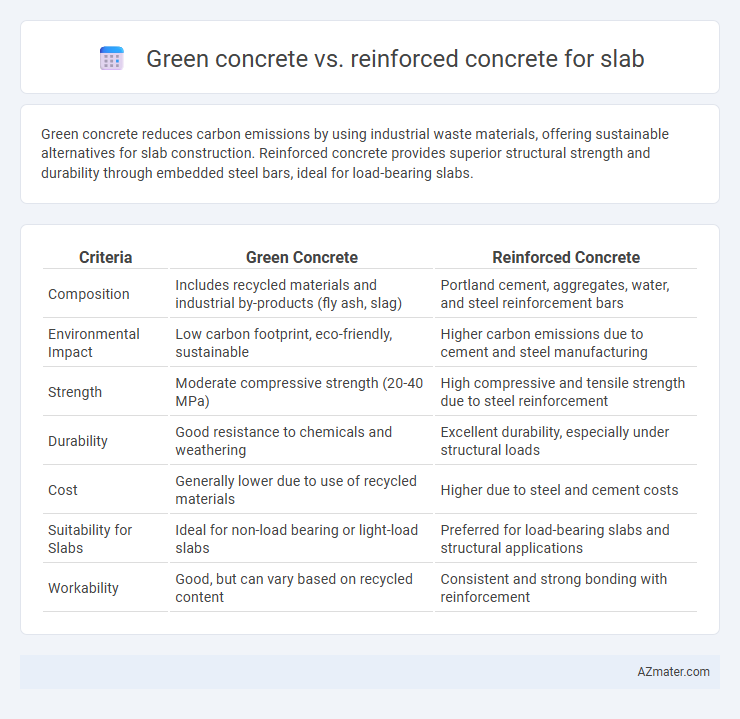Green concrete reduces carbon emissions by using industrial waste materials, offering sustainable alternatives for slab construction. Reinforced concrete provides superior structural strength and durability through embedded steel bars, ideal for load-bearing slabs.
Table of Comparison
| Criteria | Green Concrete | Reinforced Concrete |
|---|---|---|
| Composition | Includes recycled materials and industrial by-products (fly ash, slag) | Portland cement, aggregates, water, and steel reinforcement bars |
| Environmental Impact | Low carbon footprint, eco-friendly, sustainable | Higher carbon emissions due to cement and steel manufacturing |
| Strength | Moderate compressive strength (20-40 MPa) | High compressive and tensile strength due to steel reinforcement |
| Durability | Good resistance to chemicals and weathering | Excellent durability, especially under structural loads |
| Cost | Generally lower due to use of recycled materials | Higher due to steel and cement costs |
| Suitability for Slabs | Ideal for non-load bearing or light-load slabs | Preferred for load-bearing slabs and structural applications |
| Workability | Good, but can vary based on recycled content | Consistent and strong bonding with reinforcement |
Introduction: Green Concrete vs Reinforced Concrete
Green concrete, made using industrial byproducts like fly ash or slag, offers enhanced sustainability and reduced carbon footprint compared to traditional reinforced concrete. Reinforced concrete incorporates steel bars or mesh to improve tensile strength, providing superior load-bearing capacity for slabs. Both materials serve critical roles in construction, with green concrete emphasizing environmental benefits and reinforced concrete prioritizing structural performance.
Composition and Materials Used
Green concrete incorporates recycled waste materials such as fly ash, slag, and recycled aggregates, significantly reducing the demand for natural resources and lowering carbon emissions in slab construction. Reinforced concrete primarily consists of cement, water, natural aggregates, and steel reinforcement bars, providing enhanced tensile strength and durability for structural slabs. The choice of green concrete promotes sustainability by utilizing eco-friendly materials, whereas reinforced concrete emphasizes mechanical strength through conventional materials and steel reinforcement.
Environmental Impact Analysis
Green concrete significantly reduces carbon emissions by utilizing industrial byproducts like fly ash and slag as cement substitutes, lowering the embodied energy compared to traditional reinforced concrete. Reinforced concrete slabs, while structurally robust due to steel rebars, contribute to higher environmental footprints through cement production and steel manufacturing, which emit substantial CO2. Lifecycle assessments reveal green concrete slabs offer enhanced sustainability by decreasing resource depletion and minimizing greenhouse gas emissions without compromising structural integrity.
Durability and Lifespan Comparison
Green concrete, incorporating recycled materials and industrial by-products, offers enhanced resistance to chemical attacks and reduced permeability, contributing to improved durability for slab applications. Reinforced concrete slabs benefit from steel reinforcement that provides tensile strength but may be susceptible to corrosion over time, potentially reducing lifespan if not properly protected. Studies indicate green concrete slabs can achieve comparable or superior lifespan to traditional reinforced concrete, especially in aggressive environments, due to their enhanced durability characteristics and reduced environmental impact.
Structural Performance in Slab Applications
Green concrete, incorporating recycled materials and industrial by-products, offers improved sustainability while maintaining competitive compressive strength for slab applications. Reinforced concrete slabs contain steel reinforcement that significantly enhances tensile strength and load-bearing capacity, essential for resisting bending and shear forces. Although green concrete's structural performance is promising, reinforced concrete remains superior for slabs requiring high durability and critical load resistance.
Cost Considerations and Economic Viability
Green concrete, utilizing industrial by-products like fly ash and slag, often reduces material costs and lowers environmental impact, making it economically viable for sustainable slab construction. Reinforced concrete slabs require steel reinforcement, increasing overall costs due to material and labor expenses, but provide superior load-bearing capacity and durability. Life cycle cost analysis favors green concrete in terms of reduced carbon footprint and potential savings on energy and maintenance over time, enhancing long-term economic benefits.
Sustainability and Carbon Footprint
Green concrete significantly reduces carbon footprint by incorporating recycled materials and industrial by-products like fly ash and slag, lowering cement consumption and greenhouse gas emissions compared to traditional reinforced concrete. Reinforced concrete, while offering superior strength and durability for slabs, relies heavily on Portland cement and steel reinforcement, which contribute to high embodied carbon levels. Choosing green concrete for slabs enhances sustainability by minimizing environmental impact without compromising structural performance.
Installation Techniques and Workability
Green concrete features materials like fly ash and slag that improve workability by reducing water demand and enhancing flow, simplifying placement and finishing during slab construction. Reinforced concrete slabs require careful handling and positioning of steel rebar before concrete pouring, which demands skilled labor to ensure proper alignment and spacing for structural integrity. Installation of green concrete benefits from accelerated curing techniques to optimize strength gain, while reinforced concrete slabs emphasize vibration methods to prevent voids around rebars and ensure uniform compaction.
Maintenance Requirements Over Time
Green concrete for slabs typically requires less maintenance over time due to its enhanced durability and resistance to environmental degradation compared to traditional reinforced concrete. The use of supplementary cementitious materials in green concrete reduces permeability, minimizing issues like cracking and corrosion of embedded reinforcement that commonly increase maintenance needs in reinforced concrete slabs. Reinforced concrete slabs often demand regular inspections and repairs to address steel corrosion and surface deterioration, leading to higher long-term maintenance costs.
Suitability for Modern Construction Standards
Green concrete, made with eco-friendly materials such as recycled aggregates and industrial by-products, offers sustainability benefits while maintaining adequate strength for modern slab construction. Reinforced concrete, incorporating steel bars or mesh, provides superior tensile strength and structural integrity essential for heavy load-bearing slabs in modern architecture. Choosing between them depends on balancing environmental impact with structural requirements, where green concrete suits low to medium load slabs and reinforced concrete meets rigorous durability and safety standards.

Infographic: Green concrete vs Reinforced concrete for Slab
 azmater.com
azmater.com